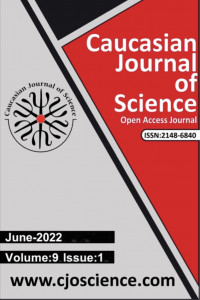Investigation of the effects of sodium phenylpyruvate on pulmonary adenocarcinoma (A549) and mammary adenocarcinoma (MDA-MB-231) on cell lines
Abstract
Kanser tedavisinde son yıllarda başarı oranını artıran ilaç ve yöntemler geliştirilmiştir. Ancak toksisitesi düşük ve yüksek derecede etkili bir ilaç üretilememiştir. Bu araştırma akciğer (A549) ve meme kanseri (MDA-MB-231) hücre hatlarında sodyum fenilpirüvatın antitümöral etkilerinin belirlenmesi amacıyla yapılmıştır. Araştırmada distile suyla sodyum fenilpirüvatın değişik yoğunluklarda çözeltileri hazırlandı. Bu çözeltilerden içerisinde 1x103 adet kanser hücresi bulunan mikropleyt kuyucuklarına sırasıyla kontrol, 0.0375 mM, 0.075 mM, 0.15 mM, 0.3 mM, 0.6 mM, 1.2 mM ve 2.4 mM’lik konsantrasyonlarından 100 mikrolitre hacimlerde ilave edildi. Aynı doz sağlıklı hücrelere de uygulandı. Her kuyucuğa 24, 48 ve 72. saatlerde CVDK-8 Cell Viability Test kitinden (Eco-Tech) 10’ar µL eklendi ve 1 saat sonra mikropleytlerin 450 nm dalga boyunda verdikleri absorbansları spektrofotometrede ölçülerek hücrelerin yoğunlukları belirlendi. Kontrol ve deney gruplarından elde edilen sonuçlar istatistiki yönden değerlendirildi. Deney gruplarda kontrole göre kanser hücre sayılarının azaldığı, hücre katlanma sayılarının ise arttığı tespit edildi. Kontrole göre en fazla azalma Akciğer Karsinom hücre hattında 2,4 mM dozda 24. saatte, Meme Adenokarsinom hücre hattında 2,4 mM dozda 72. saatte ve Human Umbilical Vein Endothelial Cells (HUVEC) hattında 1,2 mM dozda 48. saatte olduğu tespit edildi. Sodyum fenilpirüvatın akciğer ve meme kanseri hücreleri üzerine in vitro şartlarda antitümöral etki gösterdiği sonucuna varıldı.
Thanks
Acknowledgements: Thanks to Dr. Barış Yıldız for experimental applications and statistical calculations.
References
- Blau, N., van Spronsen, F. J., & Levy, H. L. (2010). Phenylketonuria. The Lancet. 376 (23), 1417-27. https://doi.org/10.1016/S0140-6736(10)60961-0
- Bussard, K.M., Gigliotti, C.M., Adair, B.M., Snyder, J. M., Gigliotti, N. T., Loc, W. S., Wilczynski, Z. R., Liu, Z-K., Meisel, K., Zemanek, C., Mastro, A. M., Shupp, A. B., McGovern, C., Maters, G. L., & Adair, J. H. (2021). Preferential uptake of antibody targeted calcium phosphosilicate nanoparticles by metastatic triple negative breast cancer cells in co-cultures of human metastatic breast cancer cells plus bone osteoblasts. Nanomedicine: NBM, 34. https://doi.org/10.1016/j.nano.2021.102383
- Chandler, J. P., & Lewıs, H. B. (1932). Comparatıve studıes of the metabolısm of the amino acıds. V. The oxıdatıon of phenylalanıne and phenylpyruvıc acıd in the organism of the rabbit. J Biol Chem, 96 (3), 619-36.
- Coban, H. B., Demirci, A., & Patterson, P. H. (2014). Elias RJ. Screening of phenylpyruvic acid producers and optimization of culture conditions in bench scale bioreactors. Bioproc Biosyst Eng, 37, 2343-52. https://doi.org/10.1007/s00449-014-1212-7
- Doğan, A., & Mutlu, N. (2019). Farmakodinami ve Toksikodnami Uygulamaları. (In: Doğan A, editor. İlaç ve Zehir Laboratuvar Uygulama Kitabı. Ankara: Akademisyen Kitabevi; s. 361-79.
- Doğan, A. (2017). Veteriner Farmakoloji. Erzurum: Eser Basım Yayın Dağıtım Matbaacılık.
- Doğan, A. (2016). Veteriner Toksikoloji. Erzurum: Eser Basım Yayın Dağıtım Matbaacılık.
- Eıdusont, S., & Dunn, M. (1956). Utılızatıon of phenylalanıne, phenyllactıc acıd and phenylpyruvıc acıd by lactobacıllus caseı. J Biol Chem, 219 (1), 175-80.
- Erdem, Ş. (2013). Fenilalanin Hidroksilaz Geninde Görülen Yaygın Mutasyonların Taranması. Yüksek Lisans Tezi. Erciyes Üniversitesi Sağlık Bilimleri Enstitüsü Tıbbi Genetik Anabilim Dalı. Kayseri.
- Fernandez-Lafuente, R., Rodriguez, V., & Guisan, J. M. (1998). The coimmobilization of D-amino acid oxidase and catalase enables the quantitative transformation of D-amino acids (D-phenylalanine) into a-keto acids (phenylpyruvic acid). Enzyme and Microb Technol, 23 (1), 28-33. https://doi.org/10.1016/S0141-0229(98)00028-3
- Foglietta, F., Canaparo, R., Muccioli, G., Terreno, E., & Serpe, L. (2020). Methodological aspects and pharmacological applications of threedimensional cancer cell cultures and organoids. Life Sci, 254. https://doi.org/10.1016/j.lfs.2020.117784
- Hahn, W. C., Bader, J. S., Braun, T. P., Califano, A., Clemons, P. A., Druker, B. J., Evald, A. J., Fu, H., Jagu, F. S., Kemp, C. J., Kim, W., Kuo, C. J., McManus, M., Mills, G. B., Mo, X., Sahni, N., Schreiber, S. L.,, Talamas, J. A., Tamayo, P., Tyner, J. W., Wagner, B. K., Weiss, W. A., & Gerhard, D. (2021). An expanded universe of cancer targets. Cell, 184 (4), 1142-55. https://doi.org/10.1016/j.cell.2021.02.020
- Hargreaves, A., Taiwo, F. A., Duggan, O., Kirk, S. H., & Ahmad, S. I. (2007). Near-ultraviolet photolysis of b-phenylpyruvic acid generates free radicals and results in DNA damage. J Photochem Photobiol B Biol, 89, 110-6. https://doi.org/10.1016/j.jphotobiol.2007.09.007
- Herreros-Pomares, A., Zhou, X., Calabuig-Farinas, S., Lee S. J., Torres, S., Esworthy, T., Hann, S. Y., Jantus-Lewintre, E., Camps, C., & Zhang, L. G. (2021). 3D printing novel in vitro cancer cell culture model systems for lung cancer stem cell study. Mater Sci Eng C, 122. https://doi.org/10.1016/j.msec.2021.111914
- Hou, Y., Hossain, G. S., Li, J., Shin, H-D., Liu, L., & Du, G. (2015). Production of phenylpyruvic acid from L-phenylalanine using an L-amino acid deaminase from Proteus mirabilis: Comparison of enzymatic and whole-cell biotransformation approaches. Appl Microbiol Biotechnol, 99, 8391-402. https://doi.org/10.1007/s00253-015-6757-0
- IBM SPSS Statistics for Windows (2017). Version 26.0. (IBM Corp. Armonk, NY: USA).
- Khan, R. L., Onodera, R., Amin, M. R., & Mohammed, N. (2002). Aromatic amino acid biosynthesis and production of related compounds from p-hydroxyphenylpyruvic acid by rumen bacteria, protozoa and their mixture. Amino Acids, 22, 167-77. https://doi.org/ 10.1007/s007260200005
- Li, J-F., Li, X-Q., Liu, Y., Yuan, F-J., Zhang, T., Wu, M. C., & Zhang, J-R. (2018). Directed modification of L-LcLDH1, an L-lactate dehydrogenase from Lactobacillus casei, to improve its specific activity and catalytic efficiency towards phenylpyruvic acid. J Biotechnol, 281, 193-8. https://doi.org/10.1016/j.jbiotec.2018.05.011
- Li, X., Bo Jiang, B., & Pan, B. (2007). Biotransformation of phenylpyruvic acid to phenyllactic acid by growing and resting cells of a Lactobacillus sp. Biotechnol Lett, 29, 593-7. https://doi.org/10.1007/s10529-006-9275-4
- Liu, M., Brusilow, W. S. A., & Needleman, R. (2004). Activity of the yeast Tat2p tryptophan permease is sensitive to the anti-tumor agent 4-phenylbutyrate. Curr Genet, 46, 256-68. https://doi.org/10.1007/s00294-004-0531-7
- Marais, C., Steenkamp, J. A., & Ferreira, D. (1996). The occurrence of phenylpyruvic acid in woody plants: Biosynthetic significance. Tetrahedron Lett, 37 (32), 5763-64. https://doi.org/10.1016/0040-4039(96)01178-1
- Mu, W., Yu, S., Jiang, B., & Li, X. (2012). Characterization of D-lactate dehydrogenase from Pediococcus acidilactici that converts phenylpyruvic acid into phenyllactic acid. Biotechnol Lett, 34, 907-11. https://doi.org/10.1007/s10529-012-0847-1
- Rodríguez-Pazo, N., Vázquez-Araújo, L., Pérez-Rodríguez, N., Cortés-Diéguez, S., & Domínguez, J. M. (2013). Cell-Free supernatants obtained from fermentation of cheese whey hydrolyzates and phenylpyruvic acid by Lactobacillus plantarum as a source of antimicrobial compounds, bacteriocins and natural aromas. Appl Biochem Biotechnol, 171, 1042-60. https://doi.org/ 10.1007/s12010-013-0408-7
- Rosa, A. P., Jacques, C. E. D., Moraes, T. B., Wannmacher, C. M. D., Dutra, A. M., & Dutra-Filho, S. (2012). Phenylpyruvic acid decreases Glucose-6-Phosphate Dehydrogenase activity in rat brain. Cell Mol Neurobiol, 32, 1113-8. https://doi.org/10.1007/s10571-012-9834-2
- Roth, V. (2006). Doubling Time Computing. Available from: http://www.doubling-time.com/compute.php. [Last accessed on: 2021 Marz 01].
- Valerio, F., Di Biase, M., Lattanzio, V. M. T., & Lavermicocca, P. (2016). Improvement of the antifungal activity of lactic acid bacteria by addition to the growth medium of phenylpyruvic acid, a precursor of phenyllactic acid. In J Food Microbiol, 222, 1-7. https://doi.org/10.1016/j.ijfoodmicro.2016.01.011
- Webert, W. W., & Zannonı, V. G. (1966). Reduction of phenylpyruvic acids to phenyllactic acids in mammalian tissues. J Biol Chem, 241 (6), 1345-9. https://doi.org/10.1016/S0021-9258(18)96780-3
- Wong, F. Y., Wong, R. X., Zhou, S., Ong, W. S., Pek, P. P., Yap, Y-S., Tan, B. K. T., Ngeowa, J Y. Y., Tana, V. K. M., Sima, Y., Tanf, S-M., Limg, S. H., Madhukumar, P., Tana, T. J. Y., Loha, K. W-J., Ong, M. E. H., & Wong, T. H. (2021). Effects of housing value and medical subsidy on treatment and outcomes of breast cancer patients in Singapore: A retrospective cohort study. The Lancet Regional Health-Western Pacific, 6. https://doi.org/10.1016/j.lanwpc.2020.10 0 065
Abstract
References
- Blau, N., van Spronsen, F. J., & Levy, H. L. (2010). Phenylketonuria. The Lancet. 376 (23), 1417-27. https://doi.org/10.1016/S0140-6736(10)60961-0
- Bussard, K.M., Gigliotti, C.M., Adair, B.M., Snyder, J. M., Gigliotti, N. T., Loc, W. S., Wilczynski, Z. R., Liu, Z-K., Meisel, K., Zemanek, C., Mastro, A. M., Shupp, A. B., McGovern, C., Maters, G. L., & Adair, J. H. (2021). Preferential uptake of antibody targeted calcium phosphosilicate nanoparticles by metastatic triple negative breast cancer cells in co-cultures of human metastatic breast cancer cells plus bone osteoblasts. Nanomedicine: NBM, 34. https://doi.org/10.1016/j.nano.2021.102383
- Chandler, J. P., & Lewıs, H. B. (1932). Comparatıve studıes of the metabolısm of the amino acıds. V. The oxıdatıon of phenylalanıne and phenylpyruvıc acıd in the organism of the rabbit. J Biol Chem, 96 (3), 619-36.
- Coban, H. B., Demirci, A., & Patterson, P. H. (2014). Elias RJ. Screening of phenylpyruvic acid producers and optimization of culture conditions in bench scale bioreactors. Bioproc Biosyst Eng, 37, 2343-52. https://doi.org/10.1007/s00449-014-1212-7
- Doğan, A., & Mutlu, N. (2019). Farmakodinami ve Toksikodnami Uygulamaları. (In: Doğan A, editor. İlaç ve Zehir Laboratuvar Uygulama Kitabı. Ankara: Akademisyen Kitabevi; s. 361-79.
- Doğan, A. (2017). Veteriner Farmakoloji. Erzurum: Eser Basım Yayın Dağıtım Matbaacılık.
- Doğan, A. (2016). Veteriner Toksikoloji. Erzurum: Eser Basım Yayın Dağıtım Matbaacılık.
- Eıdusont, S., & Dunn, M. (1956). Utılızatıon of phenylalanıne, phenyllactıc acıd and phenylpyruvıc acıd by lactobacıllus caseı. J Biol Chem, 219 (1), 175-80.
- Erdem, Ş. (2013). Fenilalanin Hidroksilaz Geninde Görülen Yaygın Mutasyonların Taranması. Yüksek Lisans Tezi. Erciyes Üniversitesi Sağlık Bilimleri Enstitüsü Tıbbi Genetik Anabilim Dalı. Kayseri.
- Fernandez-Lafuente, R., Rodriguez, V., & Guisan, J. M. (1998). The coimmobilization of D-amino acid oxidase and catalase enables the quantitative transformation of D-amino acids (D-phenylalanine) into a-keto acids (phenylpyruvic acid). Enzyme and Microb Technol, 23 (1), 28-33. https://doi.org/10.1016/S0141-0229(98)00028-3
- Foglietta, F., Canaparo, R., Muccioli, G., Terreno, E., & Serpe, L. (2020). Methodological aspects and pharmacological applications of threedimensional cancer cell cultures and organoids. Life Sci, 254. https://doi.org/10.1016/j.lfs.2020.117784
- Hahn, W. C., Bader, J. S., Braun, T. P., Califano, A., Clemons, P. A., Druker, B. J., Evald, A. J., Fu, H., Jagu, F. S., Kemp, C. J., Kim, W., Kuo, C. J., McManus, M., Mills, G. B., Mo, X., Sahni, N., Schreiber, S. L.,, Talamas, J. A., Tamayo, P., Tyner, J. W., Wagner, B. K., Weiss, W. A., & Gerhard, D. (2021). An expanded universe of cancer targets. Cell, 184 (4), 1142-55. https://doi.org/10.1016/j.cell.2021.02.020
- Hargreaves, A., Taiwo, F. A., Duggan, O., Kirk, S. H., & Ahmad, S. I. (2007). Near-ultraviolet photolysis of b-phenylpyruvic acid generates free radicals and results in DNA damage. J Photochem Photobiol B Biol, 89, 110-6. https://doi.org/10.1016/j.jphotobiol.2007.09.007
- Herreros-Pomares, A., Zhou, X., Calabuig-Farinas, S., Lee S. J., Torres, S., Esworthy, T., Hann, S. Y., Jantus-Lewintre, E., Camps, C., & Zhang, L. G. (2021). 3D printing novel in vitro cancer cell culture model systems for lung cancer stem cell study. Mater Sci Eng C, 122. https://doi.org/10.1016/j.msec.2021.111914
- Hou, Y., Hossain, G. S., Li, J., Shin, H-D., Liu, L., & Du, G. (2015). Production of phenylpyruvic acid from L-phenylalanine using an L-amino acid deaminase from Proteus mirabilis: Comparison of enzymatic and whole-cell biotransformation approaches. Appl Microbiol Biotechnol, 99, 8391-402. https://doi.org/10.1007/s00253-015-6757-0
- IBM SPSS Statistics for Windows (2017). Version 26.0. (IBM Corp. Armonk, NY: USA).
- Khan, R. L., Onodera, R., Amin, M. R., & Mohammed, N. (2002). Aromatic amino acid biosynthesis and production of related compounds from p-hydroxyphenylpyruvic acid by rumen bacteria, protozoa and their mixture. Amino Acids, 22, 167-77. https://doi.org/ 10.1007/s007260200005
- Li, J-F., Li, X-Q., Liu, Y., Yuan, F-J., Zhang, T., Wu, M. C., & Zhang, J-R. (2018). Directed modification of L-LcLDH1, an L-lactate dehydrogenase from Lactobacillus casei, to improve its specific activity and catalytic efficiency towards phenylpyruvic acid. J Biotechnol, 281, 193-8. https://doi.org/10.1016/j.jbiotec.2018.05.011
- Li, X., Bo Jiang, B., & Pan, B. (2007). Biotransformation of phenylpyruvic acid to phenyllactic acid by growing and resting cells of a Lactobacillus sp. Biotechnol Lett, 29, 593-7. https://doi.org/10.1007/s10529-006-9275-4
- Liu, M., Brusilow, W. S. A., & Needleman, R. (2004). Activity of the yeast Tat2p tryptophan permease is sensitive to the anti-tumor agent 4-phenylbutyrate. Curr Genet, 46, 256-68. https://doi.org/10.1007/s00294-004-0531-7
- Marais, C., Steenkamp, J. A., & Ferreira, D. (1996). The occurrence of phenylpyruvic acid in woody plants: Biosynthetic significance. Tetrahedron Lett, 37 (32), 5763-64. https://doi.org/10.1016/0040-4039(96)01178-1
- Mu, W., Yu, S., Jiang, B., & Li, X. (2012). Characterization of D-lactate dehydrogenase from Pediococcus acidilactici that converts phenylpyruvic acid into phenyllactic acid. Biotechnol Lett, 34, 907-11. https://doi.org/10.1007/s10529-012-0847-1
- Rodríguez-Pazo, N., Vázquez-Araújo, L., Pérez-Rodríguez, N., Cortés-Diéguez, S., & Domínguez, J. M. (2013). Cell-Free supernatants obtained from fermentation of cheese whey hydrolyzates and phenylpyruvic acid by Lactobacillus plantarum as a source of antimicrobial compounds, bacteriocins and natural aromas. Appl Biochem Biotechnol, 171, 1042-60. https://doi.org/ 10.1007/s12010-013-0408-7
- Rosa, A. P., Jacques, C. E. D., Moraes, T. B., Wannmacher, C. M. D., Dutra, A. M., & Dutra-Filho, S. (2012). Phenylpyruvic acid decreases Glucose-6-Phosphate Dehydrogenase activity in rat brain. Cell Mol Neurobiol, 32, 1113-8. https://doi.org/10.1007/s10571-012-9834-2
- Roth, V. (2006). Doubling Time Computing. Available from: http://www.doubling-time.com/compute.php. [Last accessed on: 2021 Marz 01].
- Valerio, F., Di Biase, M., Lattanzio, V. M. T., & Lavermicocca, P. (2016). Improvement of the antifungal activity of lactic acid bacteria by addition to the growth medium of phenylpyruvic acid, a precursor of phenyllactic acid. In J Food Microbiol, 222, 1-7. https://doi.org/10.1016/j.ijfoodmicro.2016.01.011
- Webert, W. W., & Zannonı, V. G. (1966). Reduction of phenylpyruvic acids to phenyllactic acids in mammalian tissues. J Biol Chem, 241 (6), 1345-9. https://doi.org/10.1016/S0021-9258(18)96780-3
- Wong, F. Y., Wong, R. X., Zhou, S., Ong, W. S., Pek, P. P., Yap, Y-S., Tan, B. K. T., Ngeowa, J Y. Y., Tana, V. K. M., Sima, Y., Tanf, S-M., Limg, S. H., Madhukumar, P., Tana, T. J. Y., Loha, K. W-J., Ong, M. E. H., & Wong, T. H. (2021). Effects of housing value and medical subsidy on treatment and outcomes of breast cancer patients in Singapore: A retrospective cohort study. The Lancet Regional Health-Western Pacific, 6. https://doi.org/10.1016/j.lanwpc.2020.10 0 065
Details
| Primary Language | English |
|---|---|
| Subjects | Environmental Sciences |
| Journal Section | Caucasian Journal of Science |
| Authors | |
| Publication Date | June 30, 2022 |
| Submission Date | August 5, 2021 |
| Acceptance Date | June 3, 2022 |
| Published in Issue | Year 2022 Volume: 9 Issue: 1 |








